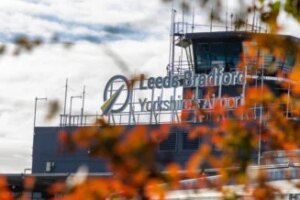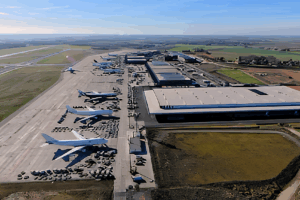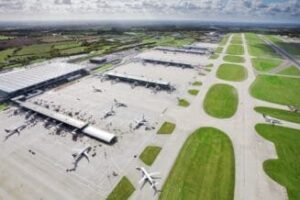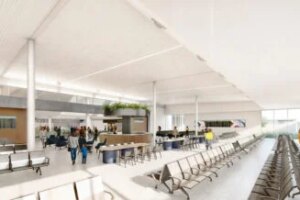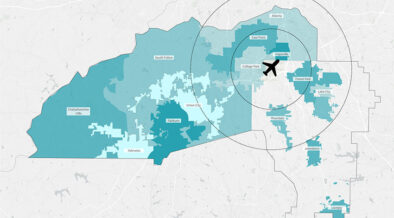
Aerotropolis Atlanta provides an example of the very best in economic master planning through regional collaboration, writes MXD Development Strategists’ Chris LeTourneur.
MULTIPLE DIMENSIONS OF AEROTROPOLIS PLANNING AND DEVELOPMENT
In addition to being multi-modal gateways for moving passengers and cargo, airports are powerful engines for catalysing regional economic growth.
Realising such potential requires collaboration between airports, adjacent public jurisdictions, regional planning agencies, transportation authorities, economic development partners, private sector businesses, and property owners.
Such collaboration unlocks investment, supports development, and stimulates clusters of economic activity.
Indeed, overcoming institutional silos, establishing shared governance frameworks, and aligning infrastructure investment and policy goals help facilitate shared prosperity and sustainable growth in areas surrounding airports, referred to as Aerotropolis regions.
The tentacles of Aerotropolis regions extend out from airports along mobility corridors, unlocking distinct economic corridors of opportunity facilitating a variety of connected land use and development segments.
These uses include logistics, advanced manufacturing, employment, innovation, education, health care, life sciences, perishables, hospitality, entertainment, events, sports, leisure, community amenities, and attainable/affordable housing.
The challenges and opportunities for evolving airport and Aerotropoli regions rest in their ability to achieve multi-jurisdictional collaboration.
AEROTROPOLIS ATLANTA
Established as a regional collaboration between various jurisdictions, public agencies, and private sector businesses, the Aerotropolis Atlanta area is a diverse sub-market of Metro Atlanta centred around Hartsfield-Jackson Atlanta International Airport (ATL).
Located twelve miles south of Downtown Atlanta and connected directly by heavy rail, public mass transit, and three interstate highways, ATL Airport is the region’s greatest asset.
Not only is ATL the busiest and most efficient airport in the world being the first airport to exceed 100 million annual passengers, but it’s the economic jewel of Georgia, generating a $34.8 billion in economic impact and providing more than 63,000 on-site jobs, making it the State of Georgia’s largest employer.
ATL is also a global gateway offering non-stop air service to more than 150 domestic and 70 international destinations.
The Aerotropolis Atlanta region involves two counties and 14 municipalities, spanning a 10-mile radius surrounding ATL Airport.

REGIONAL COLLABORATION
With the assistance of the Atlanta Regional Commission (ARC) – which facilitates Metro Atlanta’s regional land use, transportation and infrastructure planning initiatives – the Aerotropolis Atlanta Alliance (the Alliance) was formed in 2014, stimulating collaboration amongst the various jurisdictions, agencies, and corporate partners across the Aerotropolis Atlanta region.
The primary objectives of the Alliance are to drive economic development, attract investment, and improve the quality of life across the Aerotropolis Atlanta region surrounding ATL Airport.
The Alliance operates as a not-for-profit organisation, with a Board of Directors representing the broad membership within the Alliance that includes Hartsfield-Jackson Atlanta International Airport and the City of Atlanta Department of Aviation; two counties (Fulton County – Development Authority of Fulton County and Clayton County – Invest Clayton); 14 municipalities/cities (College Park, East Point, Hapeville, Forest Park, Jonesboro, South Fulton, Union City, Chattahoochee Hills, Fairburn, Riverdale, Lake City, Lovejoy, Morrow and Palmetto); and various corporate partners and agencies (Delta Airlines, Chick-fil-A, Porsche, Georgia Power, Woodward Academy, Atlanta Regional Commission, Invest Atlanta, Metro Atlanta Chamber and the Community Foundation for Greater Atlanta).
Keri Stevens, planning administrator for community development at the ARC, notes: “ARC has fully supported the Aerotropolis Atlanta Alliance since its inception with strong and engaged partnership, technical assistance, and funding through the Economic Development Administration’s Atlanta Regional Office (EDA) for the Aerotropolis Atlanta Blueprints 1.0 and 2.0 strategic planning, as well as other ARC programmes including the Livable Centers Initiative (LCI) and Community Development Assistance Program (CDAP).
“ARC’s goal is to support transformation of the communities surrounding ATL Airport to become a world-class Aerotropolis by stimulating investment and strengthening public co-ordination for all stakeholders and leverage ATL Airport’s role as an economic powerhouse.”
Shannon James, president and CEO of the Alliance, has been the strongest advocate for advancing Aerotropolis Atlanta.
He notes that “the Alliance seeks to facilitate regional collaboration to support the development of jobs, affordable housing, and economic vitality around the world’s busiest airport, ATL”.
“We are committed to working with our regional economic development partners to stimulate opportunities,” says James.
He points out that the Alliance aims to strengthen the businesses and communities surrounding ATL Airport by increasing economic competitiveness and to create a world class Aerotropolis. “A critical objective is to elevate Aerotropolis Atlanta’s neighbourhoods and build new and sustainable pathways for inclusive growth,” adds James.
AEROTROPOLIS ATLANTA COLLECTIVES
To engage Aerotropolis Atlanta Alliance partners and stakeholders, the Alliance established a highly effective trio of committees called ‘Collectives’.
There are approximately 20 people on each Collective, and Collectives meet regularly throughout the year. The following Collectives now operate within the Alliance:
- Economic Development
- Workforce Development
- Community Development
The Collective approach has been highly successful for facilitating collaboration within Aerotropolis Atlanta, with an eye not just on planning, but on implementation.
For instance, the Workforce Development Collective hosts Job Fairs to provide young and people of all ages with opportunities to meet educators and employers for occupations found across Aerotropolis Atlanta and at ATL Airport.
To this end, the Workforce Development Collective includes members from not just the Alliance partners, but also from various educational organisations and institutes, including grade schools, technical institutes, universities, and post-secondary training programmes.
AEROTROPOLIS ATLANTA BLUEPRINT 1.0 –
ECONOMIC MASTER PLAN FRAMEWORK
To provide a land use, transportation, and economic development framework for the Aerotropolis Atlanta area, the Alliance engaged Jacobs and MXD Development Strategists to prepare the Aerotropolis Atlanta Blueprint 1.0.
The resulting framework created in 2017 identified Target Economic Sectors that leverage proximity to ATL Airport and its intersection with the regional transportation and mobility system.
As illustrated in the Aerotropolis Atlanta Blueprint Compass on page 15, these primary sectors included Aerospace, Logistics, Food-Agri-Business, Bio-Life Sciences, and Multimedia Production.
To guide economic and land use development opportunities across Aerotropolis Atlanta, and act as anchors for growth, primary catalytic sites and projects were identified in Blueprint 1.0, including (most of which have now been built):
– ATL DOMESTIC GATEWAY, COLLEGE PARK
Anchored by the Georgia International Convention Center (GICC) and Gateway Center Arena, this Hotel/Office Cluster is connected to the ATL Domestic Terminal, remote parking, and Consolidated Rental Car Garage by an elevated Automated People Mover (APM).
– SIX WEST, COLLEGE PARK
A 320-acre master planned mixed-use destination adjacent to Historic Downtown College Park at the west end of ATL Airport, including a hotel cluster, retail, offices, corporate campus, golf course, entertainment, cultural centre parks, and residential uses.
– MOUNTAIN VIEW – CLAYTON COUNTY
The 395-acre international business park evolving directly east of the International Terminal of the Airport, including logistics, advanced manufacturing, offices, retail, and entertainment.
– CITY OF HAPEVILLE
Situated directly north of ATL Airport, this up-and coming 2.4 square mile historic Main Street community is going through a renaissance redeveloping with mixed-use residential and office development, as well as a thriving food and beverage dining culture.
At its south end, Hapeville’s Main Street District is anchored by the state-of-the-art Porsche Experience Center and their North America Cars Headquarter Offices, in conjunction with the Kimpton Overland Hotel.
The Porsche Experience Center features a 1.6-mile Driver Developer Track, Low-Friction Handling Circuit, Dynamics Area, Ice Hill, Off-Road Circuit, and skid pad, as well as a Porsche Restoration Center, Delivery Center, Museum, and 356 Restaurant, all directly adjacent to ATL Airport’s International Terminal area.

Hapeville also forms the eastern portion of the ‘ATL/Aerotropolis Atlanta North Aero Loop’, which connects the Porsche Experience Center with the nearby Delta Airlines Corporate Headquarter Campus, the City of East Point, the City of College Park, Six West, the GICC, and ATL Domestic Terminal.
– GILLEM LOGISTICS CENTER – FOREST PARK
A state-of-the-art regional distribution and e-commerce logistics centre on a portion of the former Fort Gillem Army Base with ability to accommodate over eight million square feet of industrial uses and half a million square feet of mixed-use buildings.
The Kroeger Distribution Hub anchors this project, with an Agri-Business Perishable Food Hub, involving temperature-controlled warehouses, baking, butchery, dairy, and produce packaging.
Other major businesses here include distribution centres for Amazon, Kuehne + Nagel, Cummins Deisel, HD Supply, Cope, XPO, Landair, Kalera, and JIT Packaging. Bluestar Studios is also on this site.
– SERENBE – CHATTAHOOCHEE HILLS
Nestled in Chattahoochee Hills, 25 minutes southwest of ATL Airport, Serenbe is a 1,400-acre master-planned mixed-use development, pioneering a new community model that connects residential units with nature, wellness, restaurants and the arts in a rural-urban setting.
AEROTROPOLIS ATLANTA BLUEPRINT 2.0 – CATALYTIC SITES
With the great success of the Aerotropolis Atlanta Blueprint 1.0 initiatives, in 2023, the Alliance updated and advanced the framework by engaging Pond & Company and MXD Development Strategists to create the Blueprint 2.0.
The Blueprint 2.0 initiative has been created in tandem with ATL’s expansive ATLNext improvement programme, recognising that as the airport grows, there will be a profound need for talent and employment, as well as housing and commercial services that accommodate these employees, within proximity to ATL Airport.
With the success of Blueprint 1.0, more public jurisdictions took interest in Aerotropolis Atlanta, so Blueprint 2.0 involved close interaction with the Alliance partners and key stakeholders to expand the scope of Aerotropolis Atlanta.
Andrew Kohr, principal at Pond & Company, explains: “We facilitated a comprehensive engagement programme to interact with the Aerotropolis Atlanta Alliance partners, as well as key stakeholders, city staff, and politicians to revisit the key issues and target economic sectors, as well as to explore how every jurisdiction could benefit from defining a development/redevelopment initiative”.

Kohr notes that the Atlanta Regional Commission (ARC) and the ATL Airport Community Improvement Districts (CIDs) were key partners in evolving Blueprint 2.0, with the objective that “the various jurisdictions would all benefit from having Aerotropolis-driven initiatives”.
In addition to the target sectors identified in Blueprint 1.0, prioritising attainable/affordable housing, and health care services, as well as improved mobility for getting people from home to their jobs, are key themes addressed by Blueprint 2.0.
Additionally, Blueprint 2.0 identifies a range of new Catalyst Sites/Projects to a higher level of detail to attract investors, developers and businesses.
Two of these sites are situated along the North Aero Loop, directly north of the Delta Airlines Headquarters Campus, while another is situated in the City of Forest Park south of ATL Airport. The new Catalytic Projects include:
– NORTHERN GATEWAY – OWENS-ILLINOIS GLASS FACTORY SITE, ATLANTA
Adaptive re-use of historic brick and shed buildings, as well as redevelopment to create a creative cluster mixed-use development comprised of 200,000 square feet of Retail, 350,000 square feet of Office & Employment space, 650 Apartment units, and 130 Live/Work units. This project is forecast to stimulate 1,800 new jobs and $1.16 billion of direct economic impact.
– NORTHERN GATEWAY – 1001 INTERNATIONAL BOULEVARD, ATLANTA
Adaptive re-use of a former Delta Airlines office building, complemented with 15,000 square feet of Retail, 300,000 square feet of Adaptive Re-Use Office space, 30,000 square feet of new Flex Office space, and 111 Town Homes to accommodate Aerospace and Health Care sectors, and adjacent Residential community. Project is forecast to stimulate 1,350 new jobs and $164 million of new direct economic impact.
– EASTERN GATEWAY – FOREST SQUARE REDEVELOPMENT, FOREST PARK
Redevelopment of existing older shopping plaza with a Mixed-Use Development involving 65,000 square feet of Retail, 85,000 square feet of Retail Mixed-Use, 14,000 square feet of Entertainment, 74,000 square feet of Community Services, 252 Mixed-Use Residential Units, and 150 Town Homes. Project is forecast to stimulate 450 new jobs and $565 million of direct economic impact.
AEROTROPOLIS ATLANTA BLUEPRINT 2.0 – COMMUNITY SITES
Blueprint 2.0 also identifies a series of Community Sites, to identify conceptual opportunities and plans for sites in in the broader range of municipalities situated in and beyond the 10-mile radius from ATL Airport.
They include (1) Mountainview, initial project of 100,000 square feet of Flex Office and 40,000 square feet of Retail and Entertainment; (2) 5711 Jonesboro Road, Morrow – University/Health Care District proposing 50,000 square feet of Retail, 477 Multifamily Residential units, 242 Student Housing units, and 85,000 square feet Flex and Innovative Research Space; (3) Dixie Road, Jonesboro – Transit Oriented Development with 90,000 square feet of Retail, 85,000 square feet of Mixed-Use, 8,700 square feet of Fast-Food Drive Throughs, 305 Multifamily/Independent Living Residential units, and 284 Residential Mixed-Use units; (4) Fairburn – Multi-Use Retail/Residential projects anchored around Charter Schools and Sports Fields with 57,700 square feet of Retail, 166 Multifamily Residential units, 75 Townhomes, 13,000 square feet of Community Building space, and 150,000 square feet of School; and (5) Old National Highway, Collage Park – Medical Health & Wellness District with 24,000 square feet of Retail, 150,000 square feet of Medical Office, and 137 Seniors Village Residential Units.
OUTLOOK
Aerotropolis Atlanta demonstrates the power of collaboration through organisational structure, partner and stakeholder engagement, and catalytic sites/projects, for addressing the multi-jurisdictional challenges and opportunities of planning land uses, development, economic activities, mobility, and communities around airports.

